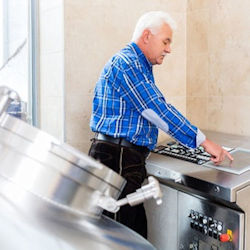The Written Plan
The written plan is an important element of the Confined Space Program because it helps to clarify what everyone is supposed to do and how to do it (a recurring theme).
If everyone understands their duties and responsibilities, and is able to perform in a professional manner, the likelihood of serious accidents will decrease significantly.
The written confined space safety plan should contain policies, processes, and procedures for the following:
- identifying and classifying confined spaces;
- evaluating permit spaces and hazards;
- developing and implementing safe entry operations;
- providing and maintaining all necessary equipment (PPE, monitors, etc.);
- evaluating permit space conditions before/during/after entry operations;
- confined space entry team duties (authorized entrants, attendants, entry supervisors);
- procedures for entering multiple spaces;
- confined space entry and rescue training;
- emergency rescue procedures;
- entry permit procedures (issue, use, cancel);
- measures to prevent unauthorized entry;
- multi-employer entry procedures;
- concluding the entry (closing off the space);
- annually evaluating permit entry operations during the year; and
- reviewing historic permits.
1910.146 App B
Procedures for Atmospheric Testing.
Workplace
- Workplaces where tank cars, trucks, and trailers, dry bulk tanks and trailers, railroad tank cars, and similar portable tanks are fabricated or serviced.
A. During fabrication
- These tanks and dry-bulk carriers are entered repeatedly throughout the fabrication process. These products are not configured identically, but the manufacturing processes are very similar.
Sources of hazards
- There are mechanical hazards from contact with tank components or tools.
- Workers may breathe harmful fumes from welding or coating materials.
- Many vapors and mists are flammable, creating fire or explosion risks without proper ventilation.
Control of hazards
- Welding: Use local exhaust ventilation once entry and exit are only through a manhole. Welding gas tanks must never be brought inside a permit space tank. Follow OSHA’s welding standard (29 CFR 1910, subpart Q).
- Application of interior coatings/linings: Use forced air ventilation to keep flammable levels below 10% of the LFL. Provide and use respirators if ventilation alone is not enough.
Permits
- Issue an "Area Entry Permit" for 1 month to cover production areas where tanks are entered through manholes.
Authorization
- Only the area supervisor may authorize entry. They must make sure conditions meet permit requirements first.
Attendant
- The supervisor will assign someone to stay in contact with employees in tanks. This person may not enter the space unless authorized by the rescue procedure and after being replaced by another attendant.
Communications and observation
- Maintain communication between attendant and entrant(s). Methods may include voice, radios, tapping codes, rope signals, or visual observation of work. High noise levels may make voice communication hard.
Rescue procedures
- May include employee-rescuer teams, emergency services, or tank breaching. The permit lists the options, but the supervisor decides which to use.
- If breaching with a torch, clean surfaces within 4 inches and keep tank atmosphere below the LFL.
Retrieval line and harnesses
- Usually impractical in tanks due to design, but rescue teams must be trained in their use unless breaching is the chosen rescue method.
B. Repair or service of “used” tanks and bulk trailers
Sources of hazards
- May contain hazardous residues from past cargo or created by chemical or bacterial actions.
Control of atmospheric hazards
- Used tanks must be emptied, cleaned without entry, and purged before being brought into entry-authorized areas.
Welding
- Remove coatings at least 4 inches from welding areas. Keep tank atmosphere well below the LFL. Follow OSHA’s welding standard (29 CFR 1910, subpart Q).
Permits
- Issue a permit valid for up to 1 year. The permit must include safeguards from the new tank fabrication rules.
Authorization
- Only the area supervisor may authorize entry. They must confirm all permit requirements are met before entry.
Knowledge Check Choose the best answer for the question.
2-2. A confined space written plan is important because it helps to _____.
You forgot to answer the question!

